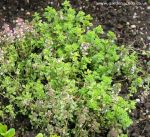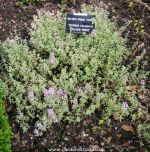Categories
Calendars
Guides
Reviews
Archive
Gallery
Articles
Ask Our Gardening Expert
Thyme deserves a place in all gardens. Its foliage is attractive, the
long-lasting flowers are very pretty and it is a compact easy-care plant.
THYME QUICK GUIDE Thyme Folklore Latin Name Type Site and Soil For Thyme Plant to Harvest Time On top of that it is one of the most useful herbs for
the kitchen. Thyme reaches a height of 30 cm (12in) and is best suited either to
the rock garden or the front of a border. Sometimes it is grown
between paving stones; it is highly aromatic and when trodden on
its scent is intensified. A native of Southern Europe, thyme is now grown the world over
from Africa to Russia - it proves it's versatility and it certainly deserves a place in your garden.
Where To Grow Thyme
Propagation of Thyme
Thyme
can be propagated in a variety of ways - seed, root division and from
cuttings. The best way if you have no existing plants is to grow from
seed. This will however take about a year. The best way for speed is to
grow from root division. Cuttings are not really recommended. Roots should be divided in
April using plants three or four years old. Dig up
the plant, clear away as much soil as possible from the roots and gently
tear the the plant into three or four pieces. The pieces (each should
have a portion of root and foliage) can then simply be planted in the
ground and left to grow. They should be ready for moderate harvesting in
early July time. Seed should be sown in
March
time in normal potting compost. Because the
seeds are so fine, only cover them very lightly with the compost. Place
them in a warm place, 16C (60F), and the seedlings will emerge in week
or so. When the plants are about 10cm (4in high) and the danger of all
frost has passed, they can be moved outside to their final position
(harden them off first). They have a spread of about 30cm (12in) and
should be spaced at this distance apart. Harvest only very, very lightly
(if at all) in the first year. Care of Thyme
Thyme
will start to become woody and produce fewer leaves after three or four
years, and at this stage, the plant should be separated (as described in
propagation above) and replanted. Harvesting can occur all year round, although the best flavour is in the months of
mid-June and
mid-July. In winter the plants stop growing, so harvest only
lightly. The thyme sprigs can be frozen or dried - both methods retain the original flavour. Thyme is virtually free of pests and disease, although they are occasionally
attacked by greenfly. Container
Growing Thyme Recommended Thyme Varieties Golden-scented Thyme (Thymus
pulegioides) - slightly lemon scented thyme, great for cooking and with
lavender coloured flowers. END OF THYME ARTICLE
Growing Thyme
Click here
Thymus vulgaris
Perennial edible herb
Light soil. in full sun
Seed - one year
Root division - three months
Thyme likes a well-drained light soil, it should not be too rich in
nutrients which will only make the plant 'leggy' and loose its compact
shape. Being a native of the Mediterranean it needs a place in full sun.
Thyme requires very little attention - water only in very dry
conditions and feed sparingly. A good mulch with organic matter in
October time will help protect them from severe frost and will also
provide most of their feeding needs. If organic matter is not available,
a handful of bonemeal per plant in
mid-May
and
July
will meet their needs.
Thyme 'Silver Posie'
Thyme is an excellent plant for growing in containers and requires
no particular attention. Water to keep the compost moist, and feed with
liquid plant food every two weeks from
April to
August.
Choosing a variety of thyme is a matter of personal taste. However, for
starters, shown below are a few tried and trusted varieties, all of which can be
bought online by clicking
().
Garden Thyme Thymus vulgaris - the original thyme used for
flavouring. Grown for hundreds of years.
Thyme Thymus serpyllum - ground cover thyme, great for cooking and
great for ground cover.
Name: Bianca
E-mail: scemaja@yahoo.com
Date posted: September 03, 2011 - 10:57 pm
Message: I live in austin,tx. It is very hot here. I bought potted herbs water them regularly but they tend to burn. Right now I bought new ones like Basil, thyme, Italian oregano, and mint (spearmint or peppermint I'm guessing). Can I keep these indoors? The apartment temp is 70 degrees air conditioning. any advice oh and i bought them already in the pot! thanks so much!!!
Name: Mahfuz
E-mail: Private
Date posted: September 01, 2011 - 12:51 am
Message: Hi,
I planted several thyme seeds in a pot.it sprouted in tiny stems but noticed thatthe stem rots when it is few centimeter tall, i watered to keep the soil moistened and also kept in full sun.i noticed all the young delicate thymes were vanished. I am planing to plant fresh. I live in a city where average day temperature is around 32 celsisus. Please advise.
Name: USHA RANI
E-mail: Private
Date posted: August 27, 2011 - 03:48 am
Message: I am in INDIA and wants to grow Thyme Herb in my garden. Kindly advise me how I can do it. Waiting for your advise.
USHA RANI
Name: sandip shah
E-mail: info@mechair.in
Date posted: November 20, 2010 - 03:59 am
Message: we want to purchase oregano seeds.
& thyme seeds or plant.please send us contects for that.
thank you.
Name: John
E-mail: Private
Date posted: November 01, 2010 - 07:53 am
Message: Thyme, Care of Thyme